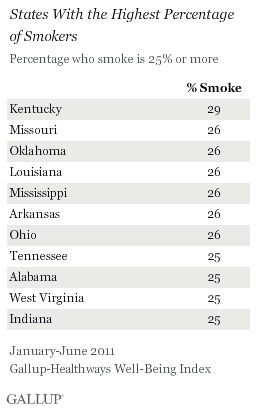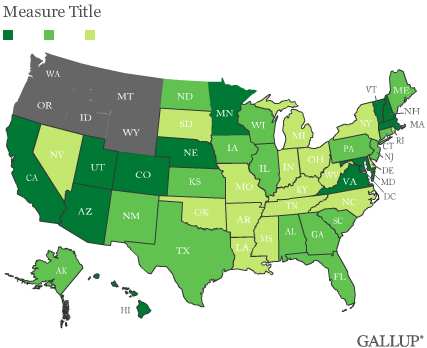WASHINGTON, D.C. -- Nationwide, smoking rates range from a high of 29% in Kentucky to a low of 11% in Utah, according to Gallup-Healthways Well-Being Index data collected in the first half of 2011.


Each day, Gallup and Healthways ask 1,000 Americans, "Do you smoke?" The January-June 2011 results are based on 177,600 interviews conducted as part of the Gallup-Healthways Well-Being Index. These results provide a preliminary picture of 2011 state smoking rates, ahead of the final full-year data, which will be available in early 2012.
As the American Cancer Society's Great American Smokeout Thursday urges smokers to attempt to quit their habit, the Gallup-Healthways Well-Being Index finds an average of 21% of all Americans saying they smoke in the first half of this year. This has gone unchanged since Gallup and Healthways started tracking Americans' smoking habits in 2008.
So far this year, there are 18 states with smoking rates lower than 20%, compared with 8 states in 2010, 11 in 2009, and 10 in 2008. There are 11 states with rates of 25% or higher, fairly similar to recent years.
Smoking Rates Remain Highest in the South and Midwest
High smoking rates continue to dominate in the South and Midwest, with all of the states where rates are 25% or higher -- the "well-above average" group -- located in these regions, except for West Virginia, which Gallup categorizes as a Northeastern state.
Fourteen of the 18 states (including the District of Columbia) where fewer than 20% of adults smoke -- the "below average" and "well-below average" groups -- are in the East or West, the exceptions being North Dakota, Minnesota, Kansas, and Virginia.

Smoking rates also tend to be higher in states that have fewer legal smoking restrictions. There are no bans on smoking in bars in all but one of the states where rates are 25% or higher and no bans on smoking in restaurants in all but two. However, smoking is banned from workplaces, restaurants, and bars in all but 3 of the 18 states where smoking rates are lower than 20%. The exceptions are North Dakota, where there is only a ban on smoking in workplaces; Idaho, where just a ban on smoking in restaurants exists; and Virginia, where there are no bans on smoking in workplaces, restaurants, or bars.
Gallup found the same relationship between state smoking rates and smoking laws in an analysis of its 2009 data. In that same analysis, Gallup also documented a relationship between smoking rates and cigarette taxes across states.
Bottom Line
The American Cancer Society is on Thursday hosting the 36th Great American Smokeout. As the annual event aimed at encouraging Americans to quit smoking gets underway, Gallup and Healthways find the national smoking rate stuck at 21%. Although this is much lower than the historic highs of around 40%, Gallup found from the mid-1940s to the mid-1970s, there remains significant variation across states, with smoking levels in many states still at 25% or higher.
This story is part of a series of midyear updates on Gallup's State of the States data. Gallup.com will report new full-year totals in early 2012 based on all 2011 surveys.
About the Gallup-Healthways Well-Being Index
The Gallup-Healthways Well-Being Index tracks well-being in the U.S., U.K., and Germany and provides best-in-class solutions for a healthier world. To learn more, please visit well-beingindex.com.
Survey Methods
Results are based on telephone interviews conducted as part of the Gallup-Healthways Well-Being Index survey Jan. 2-June 30, 2011, with a random sample of 177,600 adults, aged 18 and older, living in all 50 U.S. states and the District of Columbia, selected using random-digit-dial sampling.
For results based on the total sample of national adults, one can say with 95% confidence that the maximum margin of sampling error is ±0.2 percentage points. The margin of sampling error for most states is ±1-2 percentage points, but is as high as ±4 points for smaller states such as Wyoming, North Dakota, South Dakota, Nebraska, and Hawaii.
Interviews are conducted with respondents on landline telephones and cellular phones, with interviews conducted in Spanish for respondents who are primarily Spanish-speaking. Each sample includes a minimum quota of 400 cell phone respondents and 600 landline respondents per 1,000 national adults, with additional minimum quotas among landline respondents by region. Landline telephone numbers are chosen at random among listed telephone numbers. Cell phone numbers are selected using random-digit-dial methods. Landline respondents are chosen at random within each household on the basis of which member had the most recent birthday.
Samples are weighted by gender, age, race, Hispanic ethnicity, education, region, adults in the household, and phone status (cell phone only/landline only/both, cell phone mostly, and having an unlisted landline number). Demographic weighting targets are based on the March 2010 Current Population Survey figures for the aged 18 and older non-institutionalized population living in U.S. telephone households. All reported margins of sampling error include the computed design effects for weighting and sample design.
In addition to sampling error, question wording and practical difficulties in conducting surveys can introduce error or bias into the findings of public opinion polls.
For more details on Gallup's polling methodology, visit www.gallup.com.

